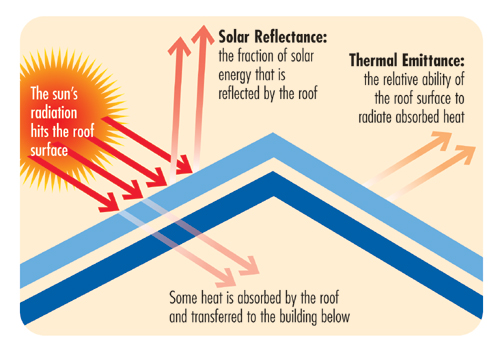Sustainable Roofing Strategies
Design Issues
Choosing roof membranes is critical to the long-term success of a watertight green roof. Roof membranes should be able to function in a wet environment, have a successful performance history, and be installed by trained applicators. Other planning and design issues that should be analyzed are as follows:
Â
|
||
Â
• Structural requirements: include reviewing the height, size, slope, and maximum loadbearing capacity of the roof. The architect should determine the type of roof structure, number and position of drainage outlets and roof penetrations, roof access locations, transport and storage availability of water and electricity, and loads imposed by green roof assemblies when fully saturated with water and plants.
• Wind uplift:Green roofs must remain stable in high wind uplift conditions. Wind pressures can vary across a roof, depending on location. At the center of the roof, a thin growing media (soil) layer of 15 lbs. per square foot (psf) may be adequate. At perimeters and corners, high winds may necessitate multiple rows of precast pavers to prevent uplift. Taller buildings have a greater risk of wind uplift. Ballasting requirements vary by building height, parapet height, and wind design speed.
• Fire prevention:Green roofs that are regularly irrigated are considered to be resistant to sparks and radiant heat. Roofs that are not irrigated are considered fire resistant provided that the growing media is two inches deep, with no more than twenty percent by weight of organic matter; gravel or concrete breaks occur in the vegetation every 100 feet, at least four feet wide; vegetation-free zones occur at all roof penetrations and at perimeter walls with openings; and safety strips are kept free of flammable vegetation.
• Roof slope: Green roofs can be placed on flat decks, but positive slope to drain is desirable. Conditions should avoid water ponding, as any ponding above the drainage layer will be harmful to plants. Various green roof assemblies can be used on flat decks up to a 3:12 pitch. Higher slopes may require special components, up to a 12:12 pitch.
• Roof drainage: Green roofs retain a high percentage of rainwater that falls on the roof, which reduces the strain on surface drainage systems. Excess water must be drained from the roof by surface roof drains, gutters, or scuppers. Roof drainage design should include at least two outlets, or an outlet and an overflow. Outlets must be kept clear of vegetation by installing a vegetation-free zone around the outlet and covering it with an inspection chamber.
• Roof penetrations: for pipes, equipment, and skylights should be clustered together, to simplify waterproofing details and allow more open planting areas. All roof penetrations and perimeters should be surrounded by gravel or other non-vegetation ballast material. Flashings should be terminated at least eight inches above the finished surface of growing media and pavers.
COOL ROOFS
Energy-efficient roofing systems can significantly reduce roof temperatures during the summer. Selecting cool roofing materials and systems that reflect the sun's radiant energy, before it penetrates building interiors, will mitigate urban heat island effects. Cool roofs encompass several different systems, materials, and installation
methods, including built up roofing, coatings, metal, modified bitumen, slate, shakes, shingles, single ply, and tiles.
Cool roofs minimize the transfer of heat to the building below by reflecting and emitting the sun's energy back to the atmosphere.
The surrounding environment is cooler, reducing the urban heat island effect and smog formation. Cool roofs benefit building owners and the environment as follows:
• Lower rooftop temperatures lead to reduced cooling loads and air conditioning use
• Less wear and tear on air conditioning systems and greater efficiency at lower temperatures
• Lower ambient air temperatures inside buildings and increased occupant comfort
• Increased roof longevity
• Reduced energy use during peak electricity demand hours avoids the need for rolling black-outs
• Lower energy use results in reduced carbon dioxide, particulate matter, and other air pollutants










